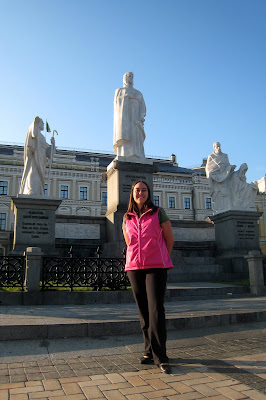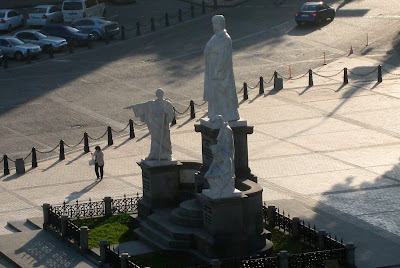Church was in Russian and Ukrainian, although, since there was a large number of English speakers—10 or so, when we broke into smaller groups, I was in the English group, there were two Ukrainian groups, and a children’s group. Instead of a sermon, we had small group discussion. I did not get the impression that it was normal, but I did enjoy hearing what other people had to say about the scripture being discussed—Zaccheus. We were then encouraged to share our testimony with at least one person this week. I received an F on my homework assignment.
In the evening, Masha, Jodi, and I went to downtown Kiev. Jodi is another teacher, from America. Masha and I met Jodi at the International Restaurant—McDonalds. From there we went back onto the Metro and explored downtown.
Masha and I at the Metro station. I would have deleted the pic where my eyes are closed, but I wanted to show the train, behind us. Thus, I kept the photo.




A government building. There were lots of important people here the evening that we visited. Everything was blocked off and you could only take pictures from a distance.








St. Michael’s Cathedral.





The carillon bells that play hourly at St. Michael's. At noon and midnight the national anthem is played.





Apostle Andrew, Olga princess Monument, and Saints Cyril and Methodius (the founders of the Slavic alphabet and literacy, hence the term the Cyrillic alphabet).
Russian is written in the Cyrillic script. It was created in the 9th century by the Saints Cyril and Methodius, two brothers born in Thessaloniki. The alphabet originally contained 43 letters - 24 of them based on the Greek alphabet. Written Russian grew out of the Slavonic writings of the Church. Today the Russian alphabet has 33 letters.
The woman statue in the middle is of Olga (945-962), she was one of the quiet Christians in Kiev history. Olga, the wife of Ihor, was depicted as being beautiful, vigorous, crafty, and above all, wise. She was given the ultimate compliment by a male chronicler informing his readers that she was "manly of mind." Vengeance was the moral prerogative of the time, Olga quickly and effectively avenged herself on her "enemies."
Olga introduced the first "reforms" in Kievan Rus' (early Kiev) establishing clearly demarcated areas from which specified amounts of tribute were to be collected at regular intervals. She also saw to it that her subjects were not deprived of all their sustenance to ensure that they would be in a position to pay tribute again. To familiarize herself with her vast domain, Olga made numerous and extensive trips to all its major town and regions. Her foreign relations were characterized by diplomacy, not war. Olga was accepted as a negotiating partner by Constantinople, the mightiest ruler in Christendom--this is a reflection of Kiev's growing importance.


The fountain of tears. This is a reproduction. In the case of the Crimean Khan that ruled the region between 1758 and 1764, a Fountain of Tears marks the passage of his ancient journey through the common experience of grief in the Crimean city of Bakhchysaray.
According to legend, the last Crimean Khan, Giri, fell in love with a beautiful Polish woman who had been captured and brought to his harem. Perhaps due to the anguish of her imprisonment or maybe as a result of a murderous plot to poison her, the Khan's paramour died unexpectedly. When the fearless ruler and warrior became paralyzed by grief, his court ordered a Persian master craftsman to construct a fountain to mark the Khan's distress.
Legend guides the meaning of the fountain. The marble flower, symbolizing the Khan's eye, fills the top cup of the fountain, the ruler's heart, with grief and sorrow. A pair of smaller cups speaks to time assuaging the pain, a pain that is later revived by the large cup in the middle suggesting memory. The pilgrimage of grief is relieved by eternity, signified by the spiral at the bottom of the fountain. Originally constructed over the young woman's tomb in a quiet garden, the Fountain of Tears was relocated to its present location in the courtyard of the Khan's Palace after Catherine the Great ordered the annexation of the Crimean region.


Pretty orthodox church.


One of the markets, many artists come to this street to sell their paintings and handy-crafts.


The long street, made with cobblestone and brick.






No comments:
Post a Comment